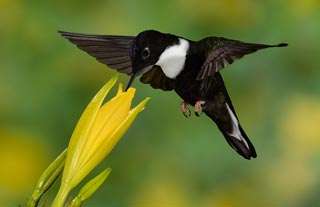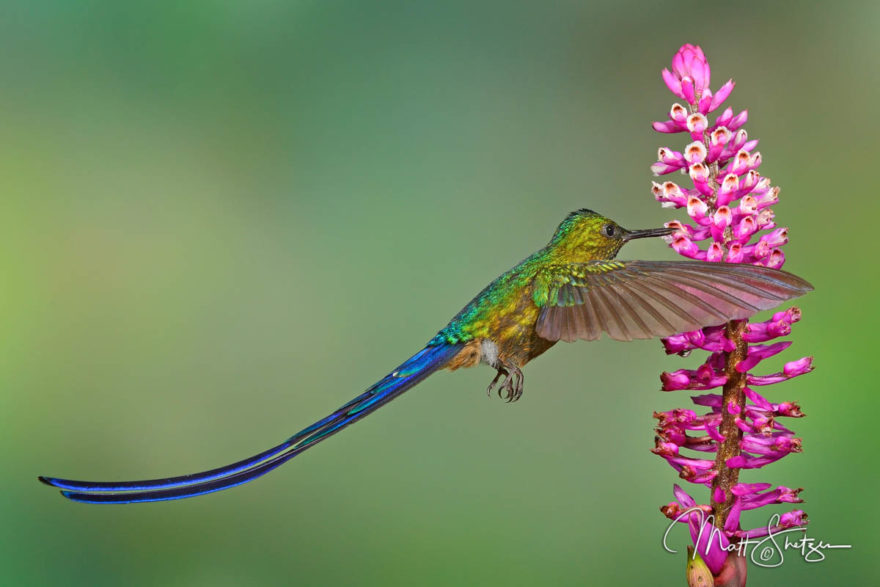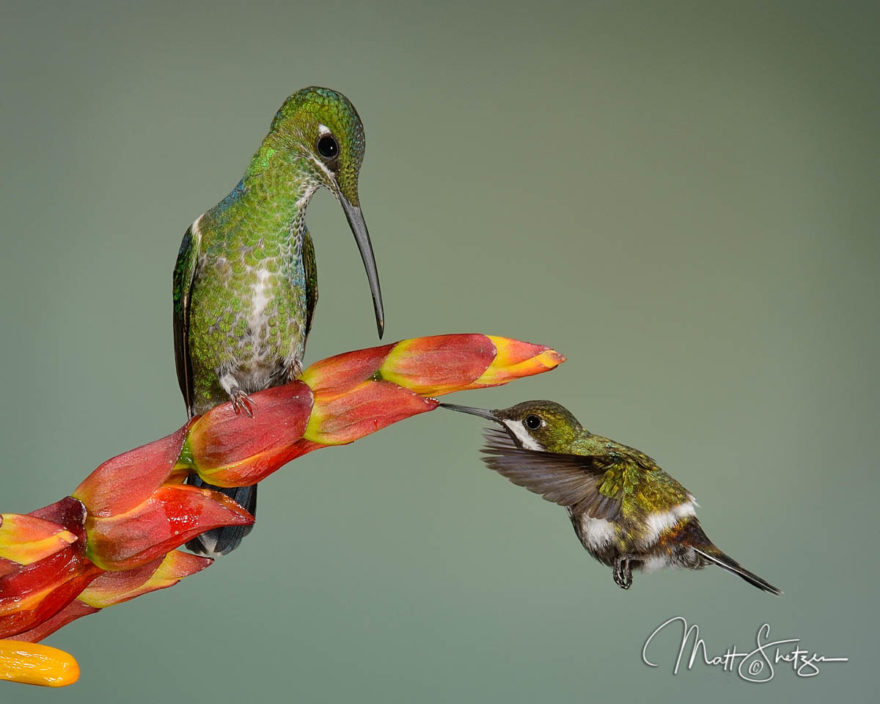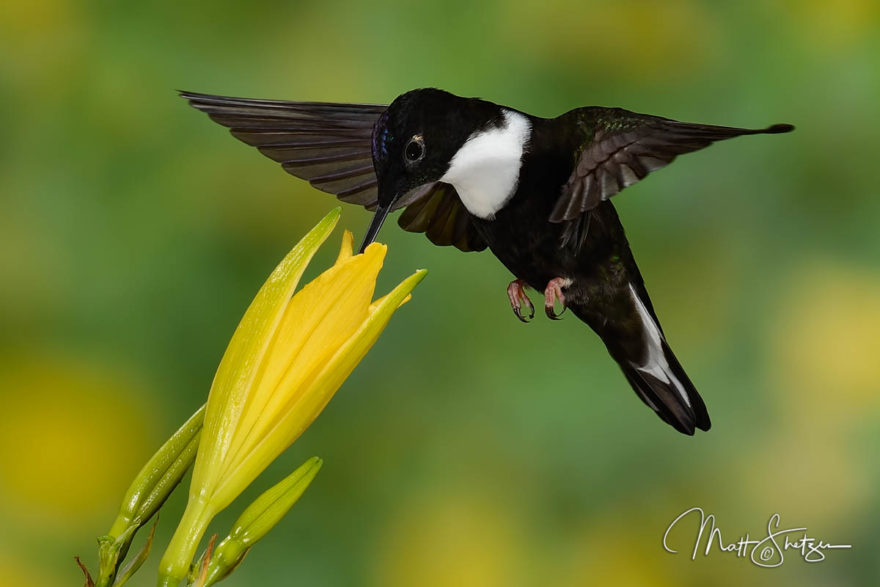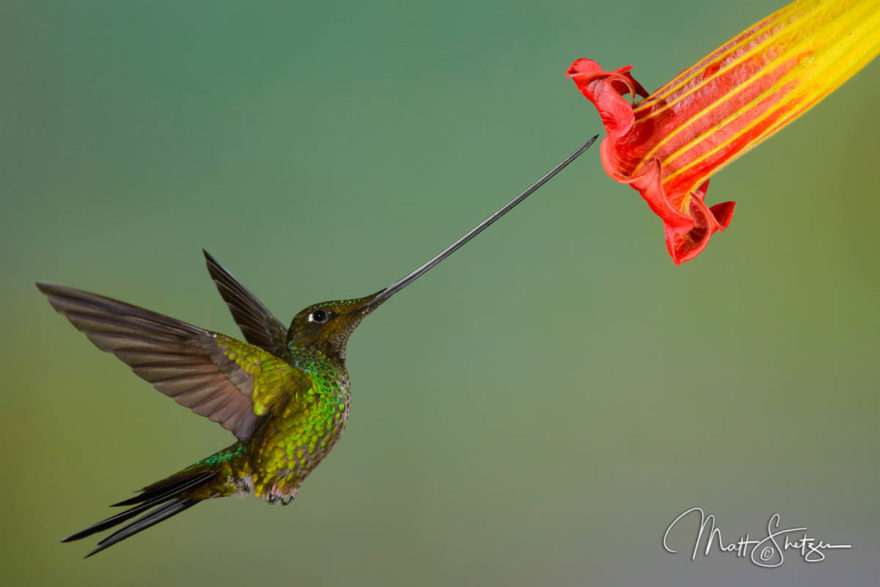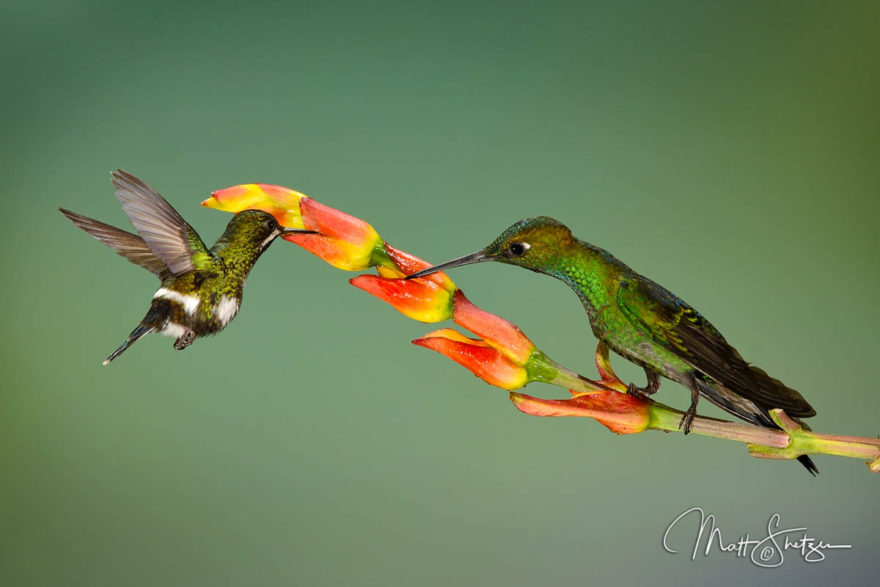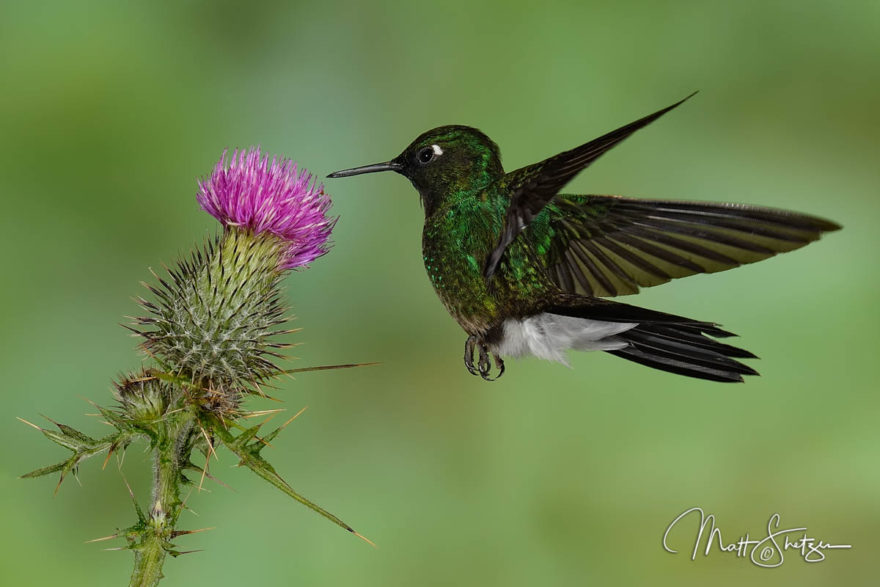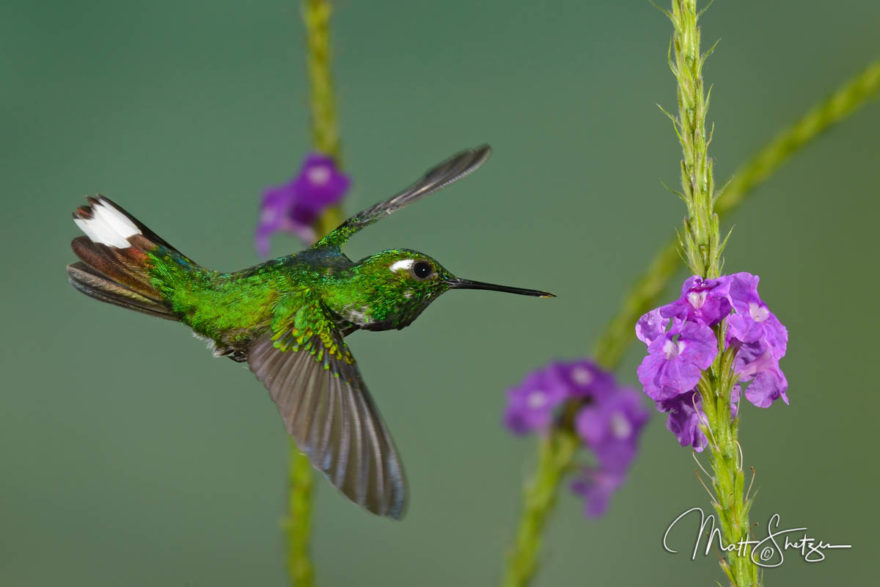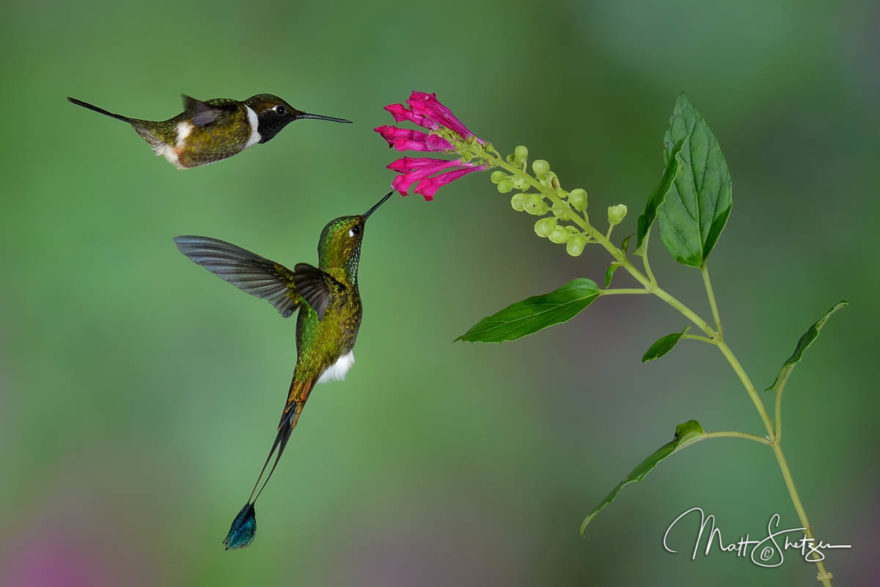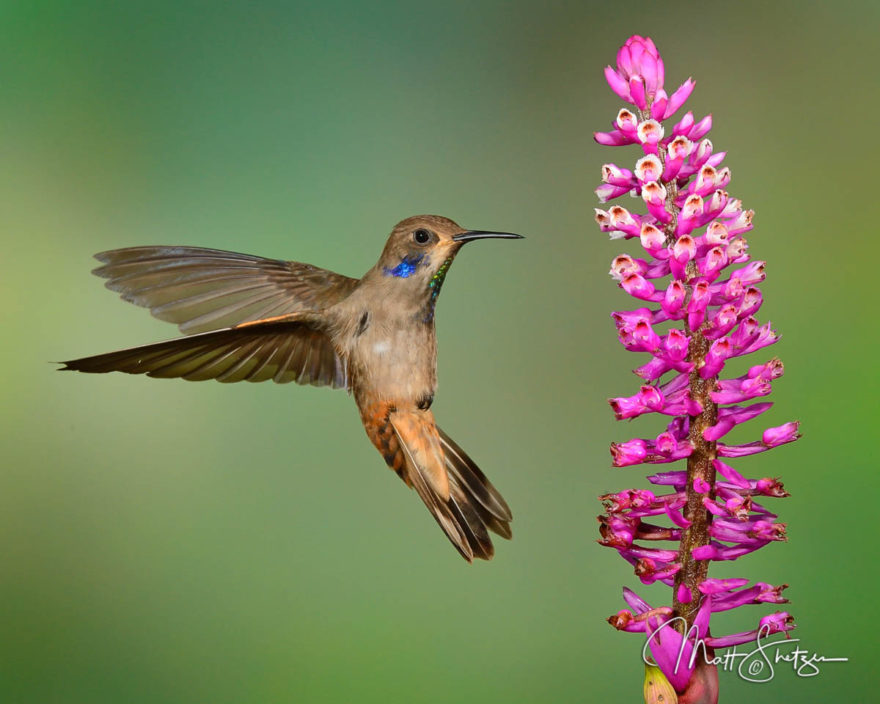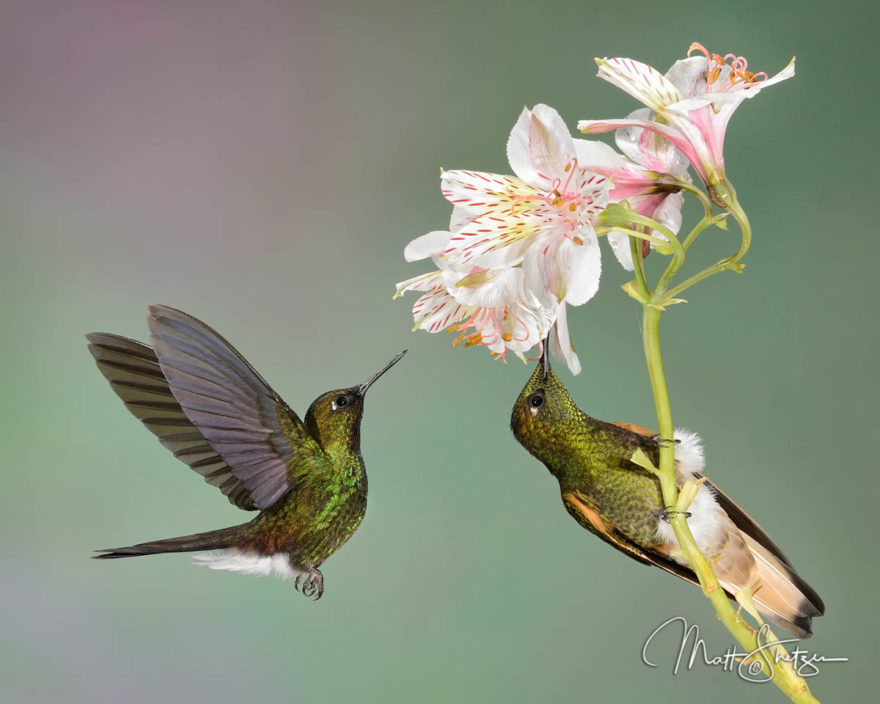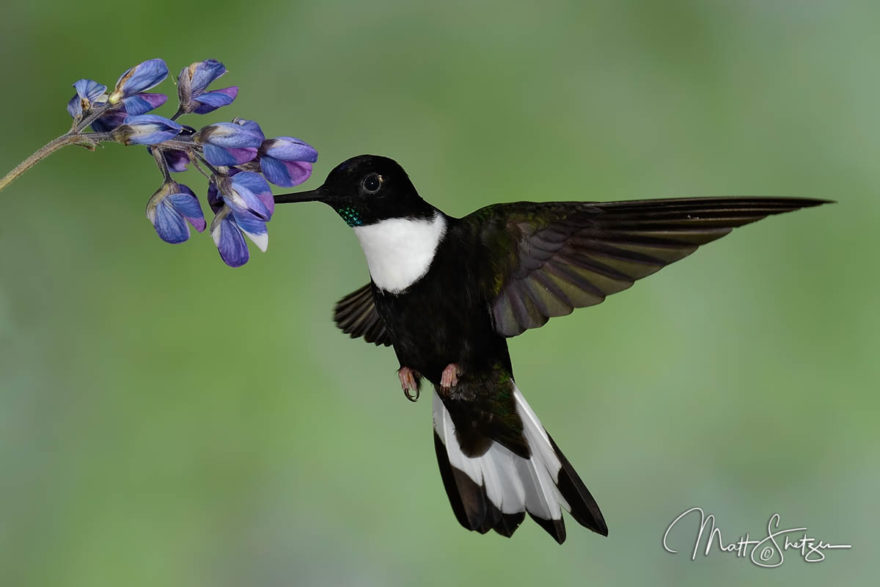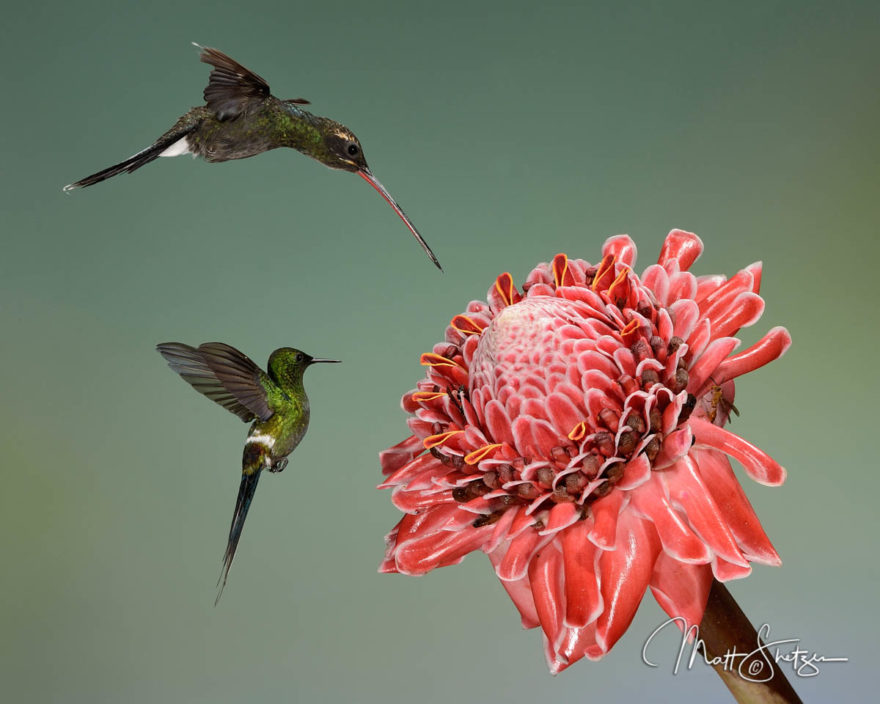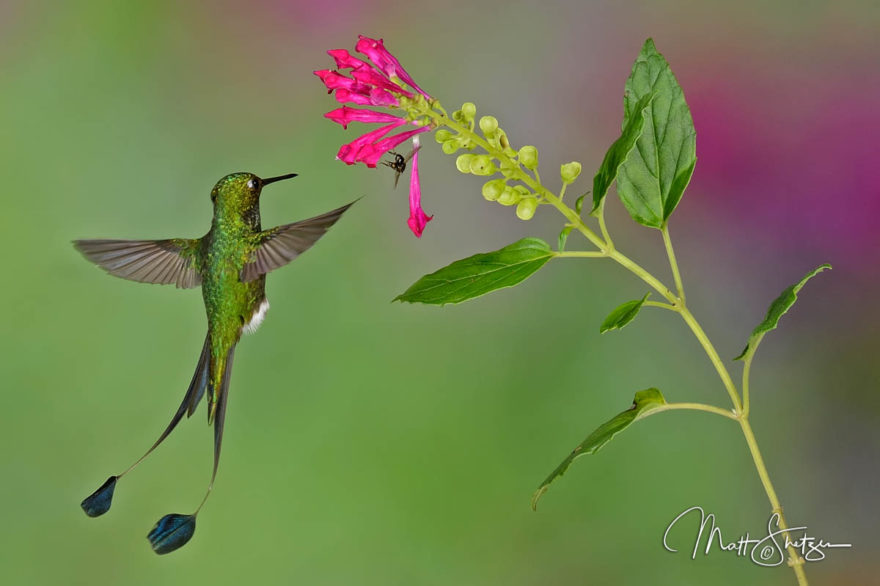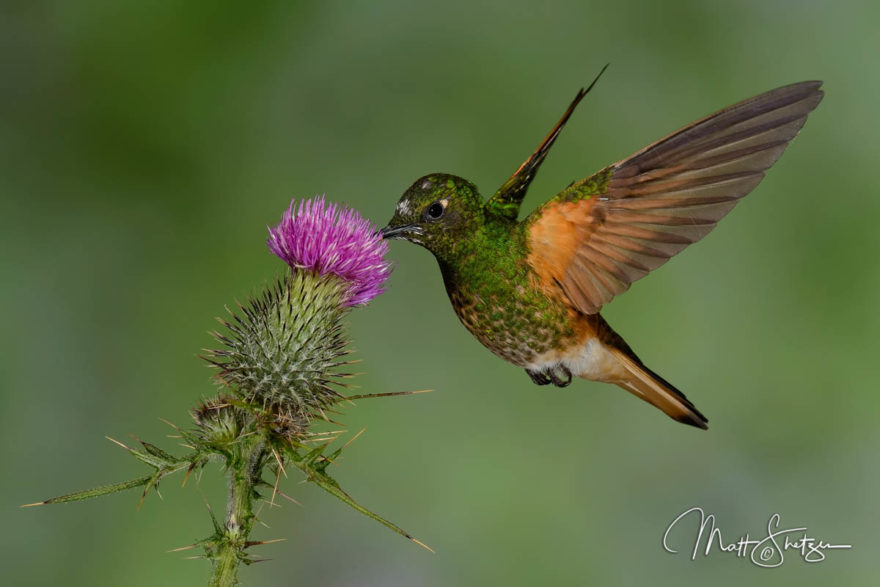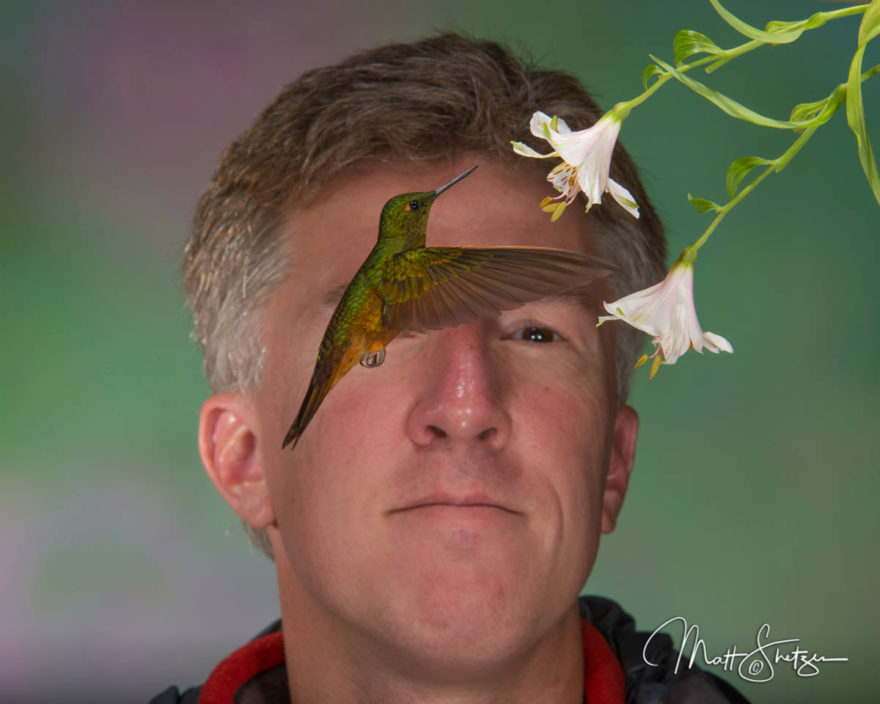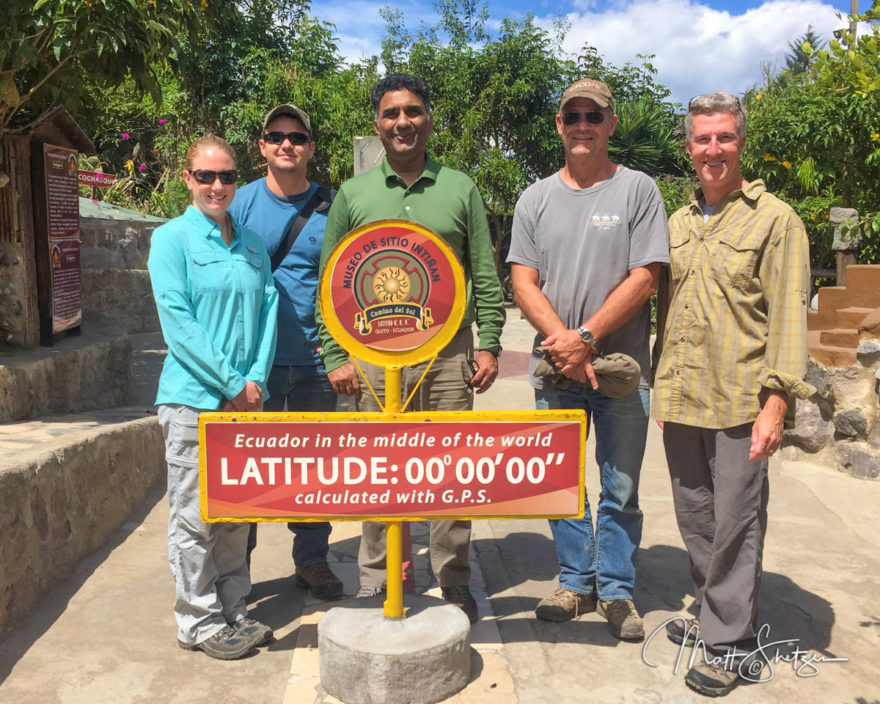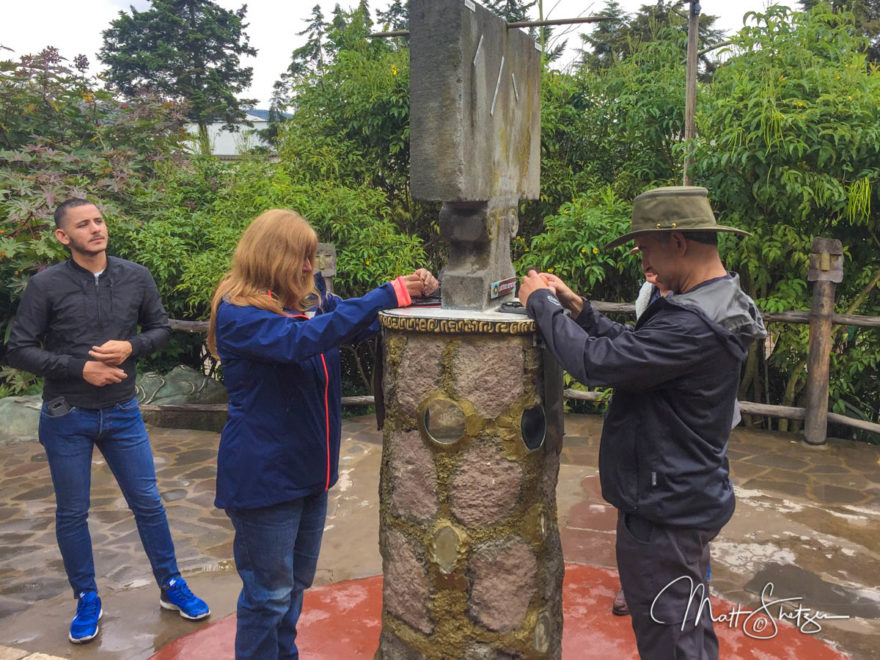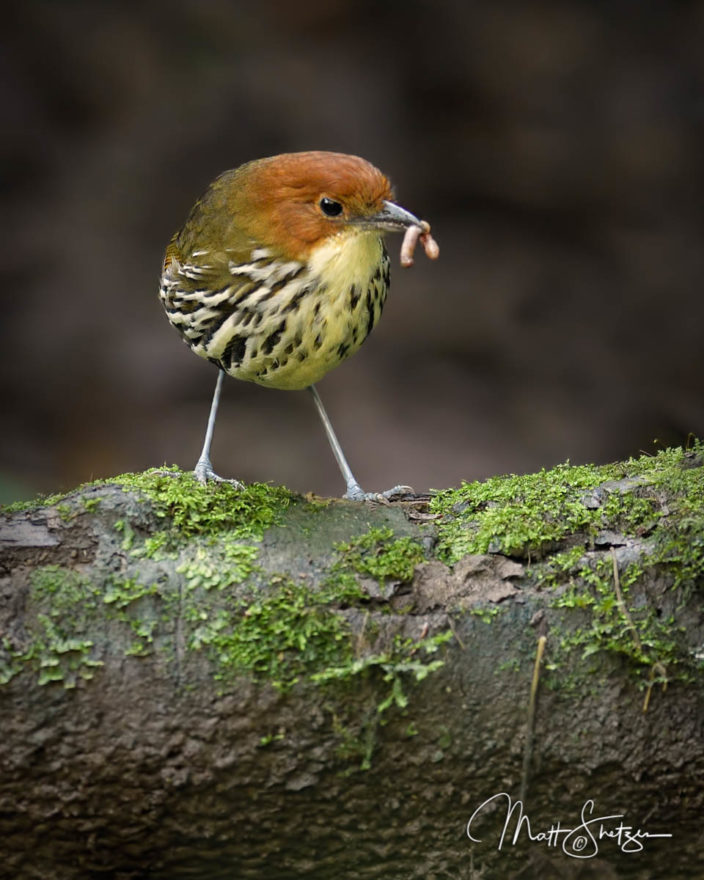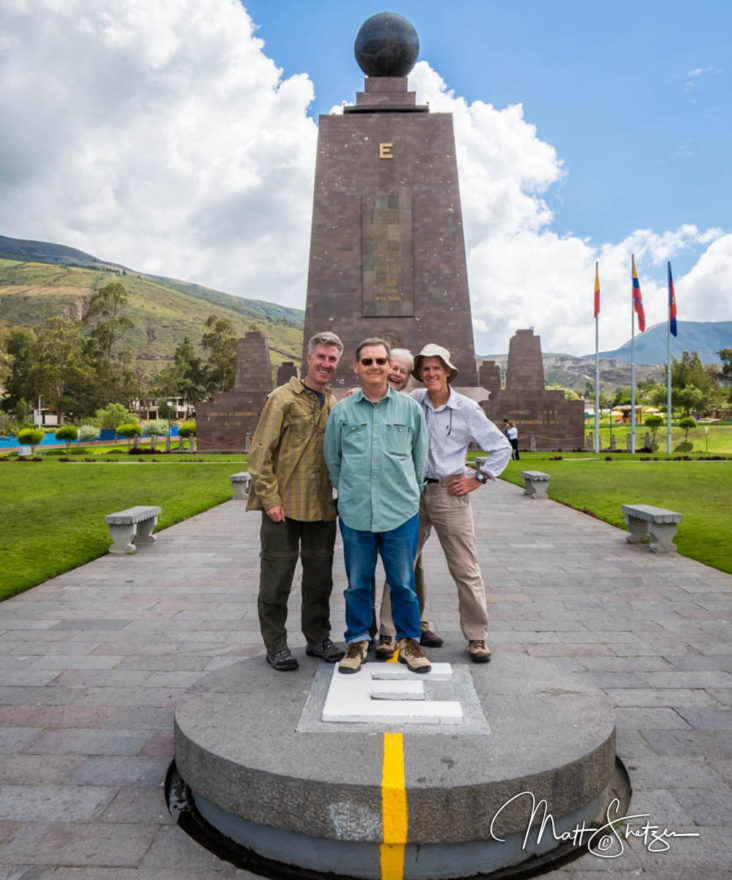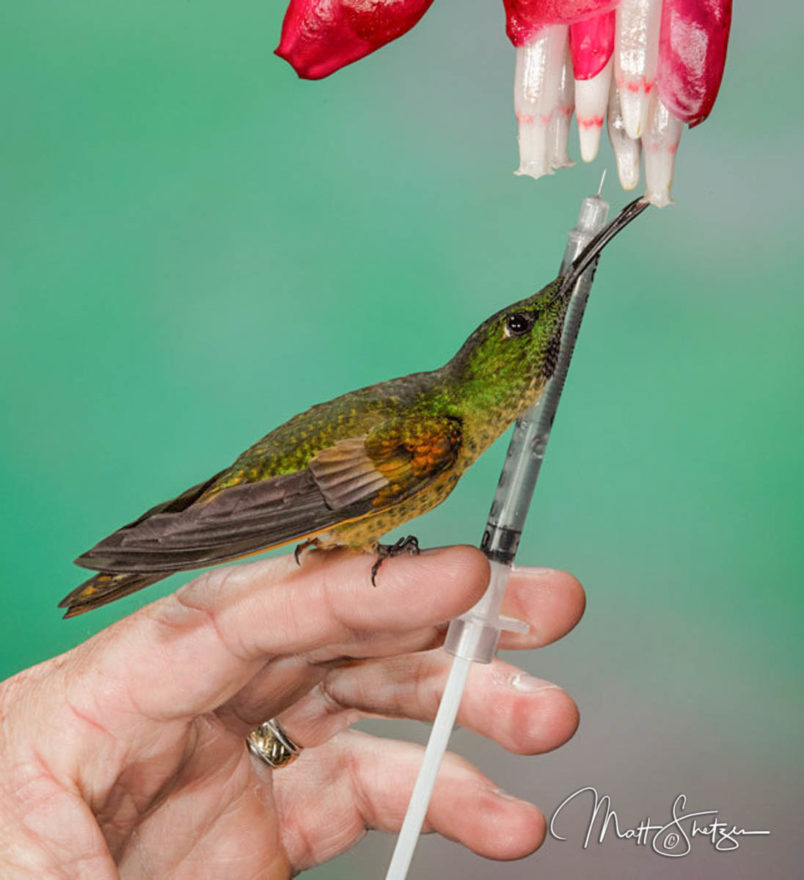Hummingbird Photo Tour
Trip Not Currently Offered
Request new trip
Important Details
Locations: Best hummingbird lodges in EcuadorFee:
- $4,995 USD per person
- Single supplement (private room) $500
Deposit: $1,000
Group Size: Max. 4 photographers—2 photographers per light setup.
Duration: 7 days, 6 nights
Skill Level: Beginner to pro
Discounts:
- Non-photographers get $250 off!
Trip Leader: Matt Shetzer
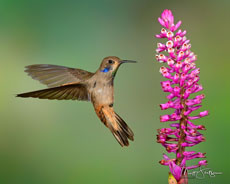 Explore the vibrant cloud forests and amazon region of Ecuador with us during our Hummingbird Photography Workshop!
Explore the vibrant cloud forests and amazon region of Ecuador with us during our Hummingbird Photography Workshop!
Over the course of the hummingbird photography workshop you will learn specialized techniques to create stunning images of hummingbirds as they feast on native flowers. In pursuit of this goal, we will journey over mountain passes and across the equator into Ecuador’s famous cloud forests.
We will visit five (5) of Ecuador’s finest hummingbird lodges. At each hummingbird lodge, you will photograph diverse species of hummingbirds and many native flowers, giving you the opportunity to create your own exclusive portfolio of exotic hummingbird pictures.
Why Ecuador for our Hummingbird Photography Workshop?
Ecuador is home to over 120 species of hummingbirds and has the best hummingbird photography opportunities than any country in the world. The lodges across Ecuador have dedicated viewing areas for various species of hummingbirds and we visit several of the most impressive hummingbird lodges, where we will photograph a rainbow of hummingbird species.
You’ll experience incredibly comfortable weather in Ecuador, ranging from 50 to 80 degrees Fahrenheit during our trip, perfect for wildlife observation.
Small Groups Only!Participants who opt for a break from photography will have opportunities to explore the history and culture of Quito, and hike amazing trails only feet from our lodges.
The best hummingbird photography is in small groups to maximize your time in the setups. Only 2 photographers per setup on this trip.
These lodges cater specifically to photographers, and have time-tested systems for attracting rare and diverse groups of hummingbirds, allowing our guests to capture many different species of hummingbirds without having to travel more than is necessary.
Although Ecuador is a beautiful country, our main purpose here is to photograph the birds!
How Do You Photograph Hummingbirds?
On this photography trip, we use advanced multi-flash setups to help us freeze these notoriously fast birds in their tracks.
We’ll be guide you in the cutting-edge, state-of-the-art techniques used to photograph hummingbirds.
These tiny birds can flap their wings up to 80 times a second, which can present quite the challenge for a photographer.
Images Taken on Our Photo Tours
We have perfected our hummingbird photography setup by using a series of seven to eight flashes synchronized by wireless radio transmitters. The multi-flash technique creates a strobe effect and freezes hummingbird wings in their tracks.
The effect is very impressive; you will notice details in your photos which would be impossible to observe in real life.
Topics we will cover:
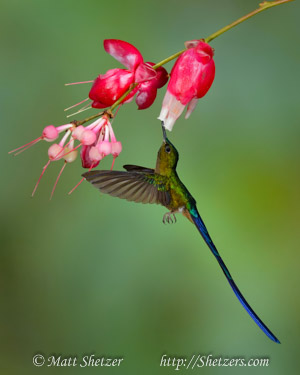
A violet-tailed sylph hummingbird drinks from a local flower in the Cloud forest.
- Master the Multi-Flash hummingbird light setup
- Balancing flash and natural light
- Natural light techniques for creating sharp and blurred wing images
- Priority exposures vs manual exposure – Benefits of each mode
- Different metering modes
- Techniques for sharp and high quality images
- Learn attractive compositions with local flowers
- Create natural looking images with flash
- Manual flash configuration to gain control
- Remote flash techniques and flash placement
- Focusing techniques for hummingbirds in flight
- Image post processing with Lightroom and Photoshop
- Best Photoshop Plug-ins to speed up post processing
Hummingbirds found at the lodges we visit
- Velvet-purple Coronet (Boissonneaua jardini)
- Sword-billed Hummingbird (Ensifera ensifera)
- Booted Racket-tail (Ocreatus underwoodii)
- Violet-tailed Sylph (Aglaiocercus coelestis)
- Long-tailed Sylph (Aglaiocercus kingii)
- Tourmaline Sunangel (Heliangelus exortis)
- Andean Emerald (Amazilia franciae)
- Brown Inca (Coeligena wilsoni)
- Brown Violetear (Colibri delphinae)
- Buff-tailed Coronet (Boissonneaua flavescens)
- Buff-winged Starfrontlet (Coeligena lutetiae)
- Chestnut-breasted Coronet (Boissonneaua matthewsii)
- Collared Inca (Coeligena torquata)
- Fawn-breasted Brilliant) (Heliodoxa rubinoides)
- Glowing Puffleg (Eriocnemis vestita)
- Gorgeted Woodstar (Chaetocercus heliodor)
- White-whiskered hermit (Phaethornis yaruqui)
- Lesser Violetear (Colibri cyanotus)
- Green-crowned Brilliant (Heliodoxa jacula)
- Mountain Velvetbreast (Lafresnaya lafresnayi)
- Purple-bibbed Whitetip (Urosticte benjamini)
- Purple-throated Woodstar (Callipholox mitchellii)
- Rufous-tailed Hummingbird (Amazilia tzacatl)
- Shining Sunbeam (Aglaeactis cupripennis)
- Sparkling Violetear (Colibri coruscans)
- Speckled Hummingbird (Adelomyia melanogenys)
- Tawny-bellied hermit (Phaethornis syrmatophorus)
- Tyrian Metaltail (Metallura tyrianthina)
- Wedge-billed Hummingbird (Schistes geoffroyi)
- Western Emerald (Chorostilbon melanorhynchus)
- White-bellied Woodstar (Chaetocercus mulsant)
- White-necked Jacobin (Florisuga mellivora)
- Empress brilliant (Heliodoxa imperatrix)
- Green-crowned woodnymph (Thalurania colombica fannyi)
ITINERARY
Day 1 –You will be greeted at the airport upon your arrival in Quito, Ecuador. Your driver will escort you to your hotel for the night, a historic colonial style seventeen century building, and just outside Quito, the second largest city in this rugged country. We will have a group dinner tonight and get to know everyone, as well as talk about the exciting days to come.
Enjoy a restful night in anticipation of the start of photography the following morning. For those arriving early, the historic center of Quito has one of the best preserved historic centers in the Americas and is great to explore.
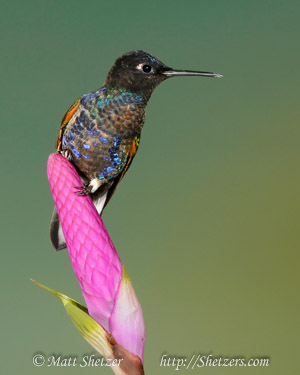
A Velvet-purple Coronet, one of the most beautifully colored hummingbirds
Workshop participants who arrive in Quito early can also enjoy adventure attractions such as rafting, mountain biking, swimming in waterfalls, climbing snow-capped volcanoes and cruising around the Galapagos Islands. There are also opportunities to see Quito’s modern side, taking scenic tours, shopping at South America’s largest market and enjoying cultural fare.
Some of the places to explore prior to the workshop include:
- Plaza San Francisco and the Church and Convent of St. Francis
- Casa Gangotena (a recently-restored historic mansion and boutique hotel)
- Carondelet Palace (the seat of government of the Republic of Ecuador)
- Basilica del Voto Nacional (the largest neo-Gothic basilica in the Americas)
- The Metropolitan Cathedral (one of the oldest and largest Roman Catholic cathedrals)
- Gold leaf interior of the Church of the Society of Jesus
- Church of San Francisco, Church of El Sagrario and Church of Santo Domingo
Day 2 – We will leave the hotel in the early morning after breakfast, and take a beautiful two-hour drive through the mountains, journeying from 8,000 feet (2,400 meters) elevation to 5,740 feet (1,750 meters). As we descend the pass you will witness two ecosystems collide as the vegetation flourishes beneath the steep mountainside and the rainforest begins.
We arrive at our first Hummingbird Lodge located in the heart of the Cloud Forest at about 10 a.m. and setup immediately to begin capturing beautiful images of some of the 24 species that visit this lodge.
The lodge features a classy and comfortable lounge, a patio and balcony – all with bird watching opportunities – as well as a dozen rooms equipped with hot water, a private bathroom and electricity, nestled amid the awe-inspiring beauty of the rainforest.
The décor of the lodge is naturally inviting, boasting a variety of wooden furniture and deep-colored tile flooring. There are also bird feeders hanging throughout the grounds, so you can see a variety of exotic birds just outside the windows.
We will spend the next 2 days photographing some of the following species of hummingbirds that frequent their feeders:
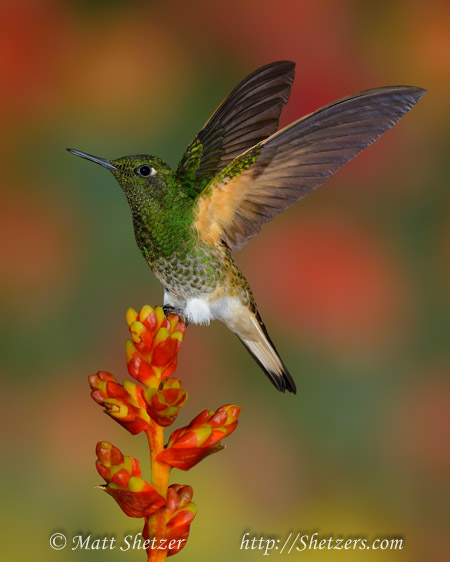
A Buff-tailed coronet hummingbird
- Violet-tailed Sylph (Aglaiocercus coelestis)
- Booted Racket-tail (Ocreatus underwoodii)
- Purple-bibbed Whitetip (Urosticte benjamini)
- Fawn-breasted Brilliant) (Heliodoxa rubinoides)
- Brown Violetear (Colibri delphinae)
- Lesser Violetear (Colibri cycanotus)
- Brown Inca (Coeligena wilsoni)
- Purple-throated Woodstar (Callipholox mitchellii)
- Western Emerald (Chorostilbon melanorhynchus)
- Rufous-tailed Hummingbird (Amazilia tzacatl)
- Andean Emerald (Amazilia franciae)
- Buff-tailed Coronet (Boissonneaua flavescens)
- Tawny-bellied hermit (Phaethornis syrmatophorus)
- Wedge-billed Hummingbird (Schistes geoffroyi)
- Sparkling Violetear (Colibri coruscans)
- White-necked Jacobin (Florisuga mellivora)
- Green-crowned Brilliant (Heliodoxa jacula)
As the day goes on, we enjoy the hospitality of the lodge as the staff prepares fantastic meals of Ecuadorian cuisine, especially their traditional soups.
Day 3 – We will be photographing all day at the bird lodge capturing dazzling images of hummingbirds from the deck and along the edge of the forest canopy. It is a great time to enjoy a hot cup of fresh Ecuadorian coffee as we photograph our colorful subjects. In your free time you are welcome to go on hikes in the Cloud Forest to view the colorful birds that are unique to Ecuador, or try to spy on some of the more secretive birds you rarely see in the wild.
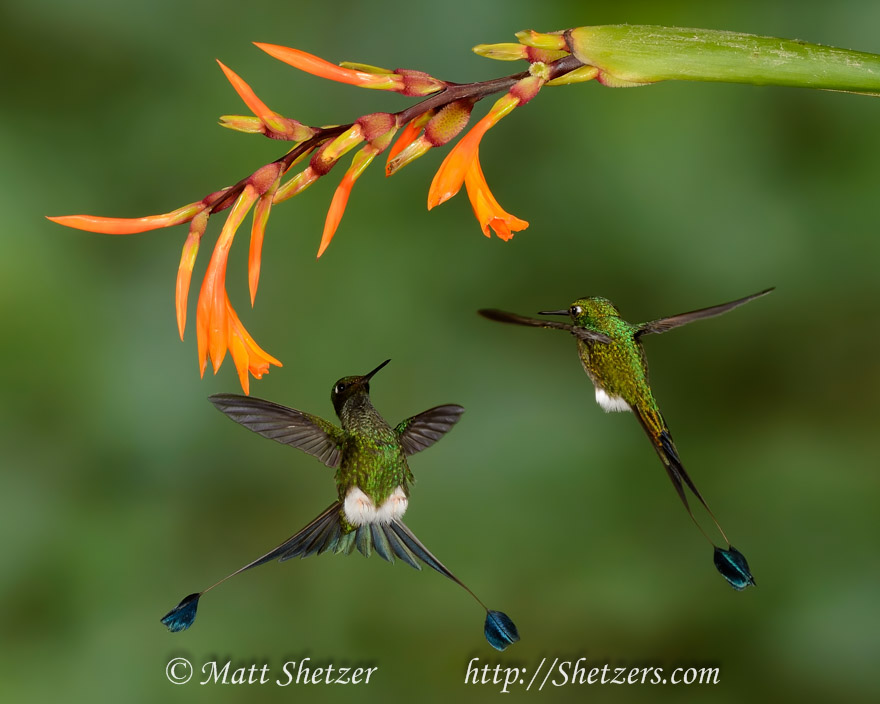
Booted racket-tail hummingbirds fight over the right to feed from a flower. Hummingbirds will attack each other to secure the rights to feed from flowers and expend large amounts of energy doing so.
Day 4 – After breakfast today, we take a day trip and venture deeper in the Mindo Loma Cloud Forest. We will visit two more lodges today to find unique bird species. Here, we will photograph one of the most beautiful hummingbirds in Ecuador, the Velvet-purple Coronet (Boissonneaua jardini). These striking jewel-toned birds provide a sensational treat for the eyes and are a favorite subject of many photographers on the trip.
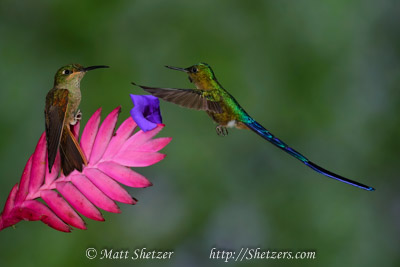
A Fawn-breasted brilliant guards its flower while a Violet-tailed sylph hummingbird tries to sneak in a feed from the flowers nectar.
Some the hummingbird species that visit their feeders include:
- Velvet-purple Coronet (Boissonneaua jardini)
- Violet-tailed Sylph (Aglaiocercus coelestis)
- Fawn-breasted Brilliant (Heliodoxa rubinoides)
- Brown Violetear (Colibri delphinae)
- Brown Inca (Coeligena wilsoni)
- Purple-throated Woodstar (Callipholox mitchellii)
- Western Emerald (Chorostilbon melanorhynchus)
- Rufous-tailed Hummingbird (Amazilia tzacatl)
- Andean Emerald (Amazilia franciae)
- Buff-tailed Coronet (Boissonneaua flavescens)
- Sparkling Violetear (Colibri coruscans)
- White-necked Jacobin (Florisuga mellivora)
- Green-crowned Brilliant (Heliodoxa jacula)
- Crowned woodnymph (Thalurania colombica)
- Gorgeted sunangel (Heliangelus strophianus)
- Hoary puffleg (Haplophaedia lugens)
- Empress brilliant (Heliodoxa imperatrix)
- Speckled hummingbird (Adelomyia melanogenys)
- Green thorntail (Discosura conversii)
Some toucans we hope to photograph while exploring the region today:
- Plate-billed mountain toucan
- Yellow-throated toucan \ Chestnut-mandibled toucan
- Pale-mandibled aracari \ Collared Aracari
- Crimson-rumped toucanet
- Choco toucan (Ramphastos brevis)
Later in the day, we will return to the lodge for another great meal and relax in the evening and talk about photography techniques.
Day 5 – This morning we depart and journey over to the Amazon region. On our way, will stop by another hummingbird lodge to work on our natural light photography of these amazing creatures.
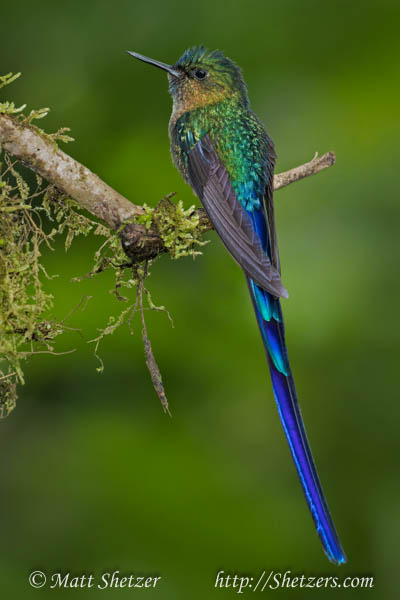
One of the most beautiful hummingbirds in the word, the Violet-tailed sylph.
- White-whiskered hermit (Phaethornis yaruqui)
- Empress brilliant (Heliodoxa imperatrix)
- White-necked Jacobin (Florisuga mellivora)
- Green-crowned Brilliant (Heliodoxa jacula)
- Tawny-bellied hermit (Phaethornis syrmatophorus)
- Brown Violetear (Colibri delphinae)
- Lesser Violetear (Colibri cyanotus)
- Sparkling Violetear (Colibri coruscans)
- Brown Inca (Coeligena wilsoni)
- Buff-tailed Coronet (Boissonneaua flavescens)
- Booted Racket-tail (Ocreatus underwoodii)
- Purple-bibbed Whitetip (Urosticte benjamini)
- Fawn-breasted Brilliant) (Heliodoxa rubinoides)
- Purple-throated Woodstar (Callipholox mitchellii)
- Western Emerald (Chorostilbon melanorhynchus)
- Rufous-tailed Hummingbird (Amazilia tzacatl)
- Andean Emerald (Amazilia franciae)
- Green-crowned woodnymph (Thalurania colombica fannyi)
- White-throated wedgebill (Schistes albogularis)
After a nice lunch on the porch overlooking the gardens, we will continue to our next lodge to see a completely different variety of hummingbirds, including the Sword-billed Hummingbird (Ensifera ensifera) The sword-billed hummingbird is the only species of bird with a bill longer than its body. This adaptation allows it to feed on flowers with long corollas such as Passiflora mixta. It also has an unusually long tongue.
On our expedition, we pass the equator (Latitude 00’ 00”), or known in Spanish as the “Mitad del Mundo” and stop for a quick tour and to take some photos. From here, we head back through the hustling and bustling city of Quito and climb up into the mountains to our highest peak of the trip, the Papallacta Pass. We’ll stop to take some photos while taking in the breathtaking scenery at over 13,000 feet (4,000 meters). As we cross the over the pass and descend into the valley, we will once again watch the landscape change. We’ll take advantage of the opportunity to stop to gather some native flowers for our hummingbird photos before we arrive at the hummingbird lodge in the evening to enjoy some refreshments and relax for an evening by the fire.
The lodge offers an ideal mix of comfort and nature. Modern conveniences are provided through charming rooms, cozy fireplaces and Ecuadorian home-style food. Social areas provide a place to relax, and refreshments are offered to guests all day long. The lodge also boasts an orchid garden and hummingbird feeder stations dot the grounds.
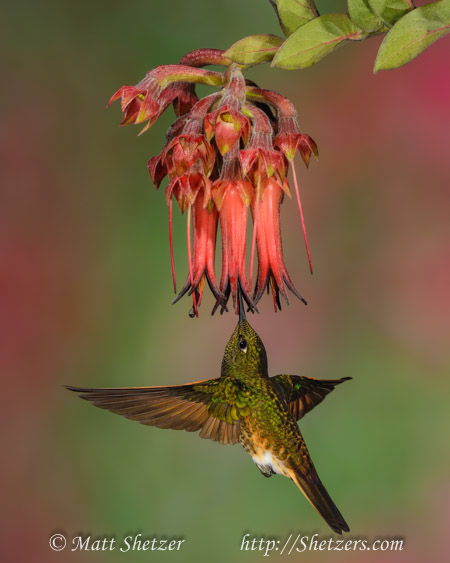
Buff-tailed coronet hummingbird drinks from a red flower in flight.
Day 6 – We will spend the next two days photographing at our third lodge. Surrounded by forest-covered mountains, the lodge offers scenic vistas and a variety of trails. It’s not uncommon to spot more than a dozen fascinating species of hummingbirds in less than an hour.
Some the species that visit their feeders include the:
- Sword-billed Hummingbird (Ensifera ensifera)
- Chestnut-breasted Coronet (Boissonneaua matthewsii)
- Lesser Violetear (Colibri cyanotus)
- Speckled Hummingbird (Adelomyia melanogenys)
- Purple-backed Thornbill (Ramphomicron microrhynchum)
- Violet-tailed Sylph (Aglaiocercus coelestis)
- Fawn-breasted Brilliant (Heliodoxa rubinoides)
- Tyrian Metaltail (Metallura tyrianthina)
- Golden-breasted Puffleg (Eriocnemismosquera)
- Mountain Velvetbreast (Lafresnaya lafresnayi)
- Shining Sunbeam (Aglaeactis cupripennis)
- White-bellied Woodstar (Chaetocercus mulsant)
- Collared Inca (Coeligena torquata)
- Buff-winged Starfrontlet (Coeligena lutetiae)
- Buff-tailed Coronet (Boissonneaua flavescens)
- Tourmaline Sunangel (Heliangelus exortis)
- Glowing Puffleg (Eriocnemis vestita)
- Gorgeted Woodstar (Chaetocercus heliodor)
Day 7 – On our final day we will spend the morning photographing hummingbirds in their beautiful habitats where orchids hang from mossy branches and temperate forests teem with flocks of birds. In the late afternoon, we’ll drive back up the pass, taking in beautiful scenery and stopping for photo ops along the way. Transportation will be arranged from the lodge directly to the airport for your evening departure. From here we say our goodbyes and begin the journey home or on to our next adventure.
If you have extra time, there’s a abundance of activities to enjoy throughout the area:
- The historic center of Quito is lined with captivating architecture of priceless churches, chapels, monasteries and convents, museums and colonial plazas. It is one of the first places to be declared World Cultural Heritage Sites by UNESCO and is one of the largest, best-preserved historic centers in the Americas.
- A visit to the Galapagos Islands provides exciting opportunities to walk along sandy beaches, watch sea-lions and tortoises, snorkel with sharks and explore the lush landscapes of the islands which inspired Charles Darwin’s evolutionary theory.
- Avid birdwatchers will enjoy the myriad of colorful birds and other amazing wildlife species found along the Amazon River in Ecuador. A variety of activities are offered in the jungle habitat of the Amazon, including birding hikes, canoe trips, night excursions and fishing for piranhas.
(Tour schedules are subject to change due to changes in weather or other unforeseen events.)
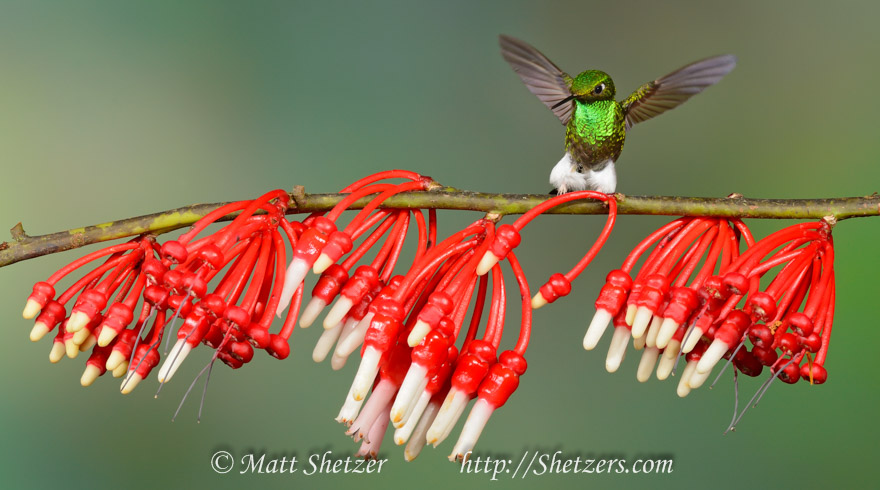
The original image I wanted was to have the Booted Racket-tail feeding on the flower while in-flight. However, this little guy kept landing on top, therefore I changed my multi-flash setup, and he came in and posed for the photograph. I guess that is why they call it wildlife.
PRICE INCLUDES
- 6 nights’ accommodation at premier bird lodges. Double occupancy (Single Occupancy available)
- Transportation to and from the Quito airport
- Transportation between lodges
- All meals are provided during the workshop. Expect to gain a couple of pounds on the trip.
- The use of multi-flash setups containing flashes, radio triggers, light stands and backgrounds.
- Instruction in the field with your photographer guide, with a maximum of 4 photographers per guide
- Photography instruction on photo editing techniques
- A planning package that includes recommendations on the proper camera gear and clothing
- We take care of all the trip logistics once guests reach Quito, so the only thing you should concentrate on is having a fantastic time and capturing stunning images of hummingbirds.
- Prior to embarking on your journey, we are happy to provide a free phone consultation with your trip leader, who will give you guidance on what equipment to bring, answer questions about the locale, and give general photography advice to make sure you are ready to capture your dream image.
NOT INCLUDED
- Transportation to/from Quito, Ecuador
- Alcoholic drinks
- Lodge and driver tips
- Travel/Cancellation/Emergency evacuation insurance
- Personal Items
- If you would like to spend a day with a bird guide, we can certainly arrange that for you in advance with the lodges. (Additional costs would apply, paid directly to the lodge.)
PREVIOUS TRIPS
Read our 2013 Hummingbird Photography Workshop Trip Report.
Read our 2018 Hummingbird Photography Workshop Trip Report.
Why do we go to Ecuador? Ecuador is home to over 132 species of hummingbirds. Look at this short video from the 2012 photography workshop. How many different species can you count?
Here is a short 30 second video to show the activity at a hummingbird feeder at our third hummingbird lodge. The video was filmed during the 2013 Hummingbird Photography Workshop.
To play the video with Full Screen, click the button on the bottom right of the player.
You can even have fun with an Iphone in Slo-Mo Video mode with the hummingbirds.
PHYSICAL REQUIREMENTS
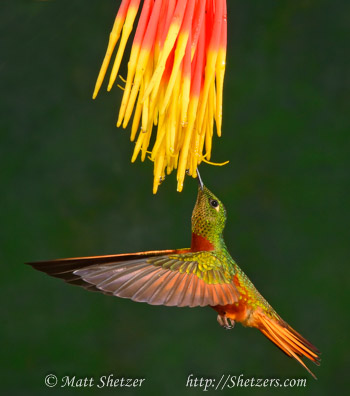
The beautiful coloring of the Chestnut-Bellied Hummingbird.
Hummingbirds of Ecuador is one of our easiest workshops physically. You will need to walk about 100 feet on cobbled path. Our shooting takes place primarily from the patios at the lodges, therefore those with limited mobility won’t have any problems.
For those who enjoy hiking, there are numerous trails at each lodge to explore.
If you are concerned about the physical demands of this trip, please contact us and we would be glad to discuss the typical day and options for your needs.
PHOTOGRAPHY SKILL LEVEL
We welcome any and all photographers from beginners to professionals.
WEATHER CONDITIONS
Weather in Ecuador is very comfortable. It ranges from 70 to 80 degrees Fahrenheit at two of our lodges. The weather at the third lodge is a little cooler and ranges from 55 to 75 degrees Fahrenheit.
TRIP LEADER
Matt Shetzer – Matt has been photographing hummingbirds for more than a decade, and loves being outside watching these amazing birds. Sharing this beauty with our guests is always a highlight of the year. To read more about Matt, click HERE.
INSTRUCTIONAL TOPICS
- Learn how to set up and configure a multi-flash setup to achieve high quality natural looking hummingbird images and freeze the high-speed action of these amazing birds.
- Instruction on how to photograph hummingbirds in natural light
- Proper exposure for the scene
- Getting the most out of the histogram
- Focus techniques for that crisp image
- Achieving the best composition
- Motion blur to add movement to your images
- Mastering the modes (When to shoot Manual, Aperture and Shutter Priorities)
- Image workup techniques with Photoshop and Lightroom. At each workshop, we demonstrate how to work up attendees’ images from scratch, displaying our nondestructive techniques to produce the highest quality image.
- Best Photoshop Plugins to use
- Color Correction
- Layers and Masks (Masks are targeted adjustments)
- Noise reduction and sharpening techniques
- Lightroom and portfolio management
- Photography discussions – We’ll review select images and discuss which images work and why to expand your skills and move to the next level
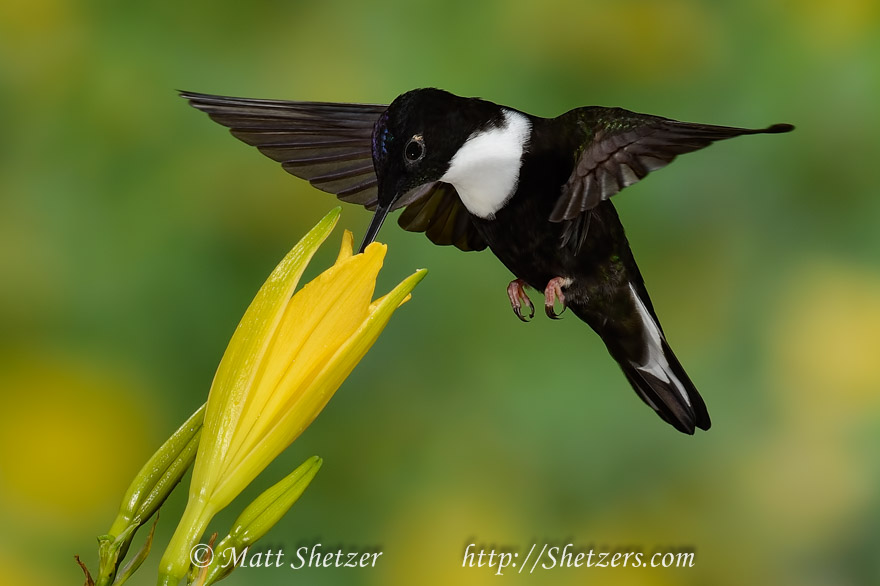
A Collared Inca hummingbird from Ecuador pictured close-up feeding on a yellow flower.
CAMERA EQUIPMENT TO BRING
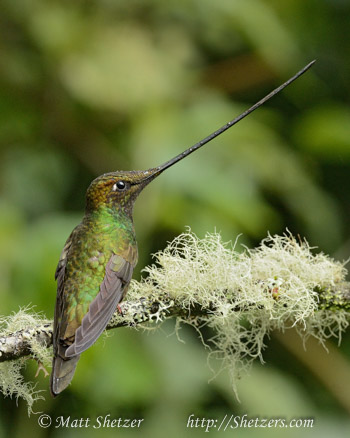
The Sword-billed Hummingbird displays its impressive beak while perched on a mossy branch. The sword billed hummingbird is the only bird species whose beak is longer than its body, and the bird holds its bill up high while it rests to avoid toppling over.
- A telephoto lens from 200 to 400mm (500-600mm can be used as well but not necessary)
- A wide-angle lens from 24-100 for landscapes
- Tripod with Gimbaled or Ball Head
- Remote Trigger\Cable release
- Lots of memory cards. We typically shoot about 1,000 images a day so bring plenty of memory cards.
If you need assistance selecting gear to meet your photography goals just let us know. All guests will receive a detailed planning package to assist in the process prior to the trip and optional phone consultation.
NON-PHOTOGRAPHER GUESTS
The Ecuadorian rainforest and its fantastic bird lodges provide a spectacular experience for anyone involved on the hummingbird photography tour. Non-photographers are welcome to join us in the field and join in on all activities with a discount of $250.00.
CLIENT COMMENTS
Read what our fantastic guests are saying about our workshops. Client Comments
CANCELLATIONS/TRIP INSURANCE
We strongly recommend all participants purchase trip insurance purchased from a third-party operator to protect your travel investment against medical emergencies, participant trip cancellations, trip interruption and delay, weather delays, missed connections, baggage loss or delay, emergency evacuation and repatriation or simply ‘Cancel for any reason coverage’.
Because Shetzers Photography must pay fees for reservations and leases of accommodations and transportation needs of the group far in advance of the workshop, all paid tour fees are non-refundable, non-transferable and cannot be applied to a future workshop. Shetzers Photography runs small group workshops and wants to ensure the workshops are not canceled due to participant cancellations thus impacting the participants who do not cancel. All tour cancellations must be submitted in writing and will result in loss of deposit and all fees paid.
Please review our Workshop Terms and Conditions.
COVID-19 and Variants Policy
If regulatory restrictions in the hosting location prevent the workshop from running as scheduled, the workshop will be rescheduled to a future date. All participants must meet hosting country vaccination requirements. No refunds or rescheduling will be allowed due to guest cancellations when the workshop is able to run following all host location regulatory restrictions.
WAITING LIST – IF A TRIP IS SOLD OUT
Over the last few years all of our trips have sold out. We start to fill up about a year before the workshop and keep the website updated with the current workshop availability. If a workshop is full\sold out you can add your name to the waitlist. If a spot becomes available we will contact the guests immediately on the waitlist in the order they signed up. We tend to have the most cancellations 90-180 days before a trip starts so being on the waitlist can help you get on a sold out trip. We require no deposit to be on the waitlist.
PAYMENT/RESERVATIONS
The cost for the tour is $4,995.00 based on double occupancy. We do offer single accommodations for an additional $500.00 per person.
To reserve a spot on this tour, we require a $1,000.00 deposit per person that is paid by credit card at the time of registration. Full tour payments must be completed 90 days prior to the start of the tour and are paid by check or bank transfer.
Once the final trip payment has been received, the detailed trip planning documents will be sent to each guest to assist in planning for the best photography workshop.
Our workshops are based upon a first come, first serve basis. Workshop availability will be updated on this page.
If you have any additional questions or would like to speak to one of us, please contact us at 303-888-2710 and we would be happy to answer your questions.

